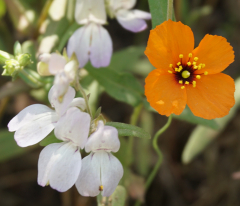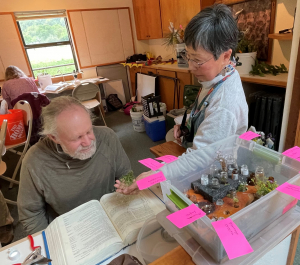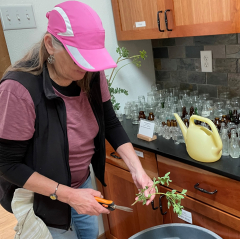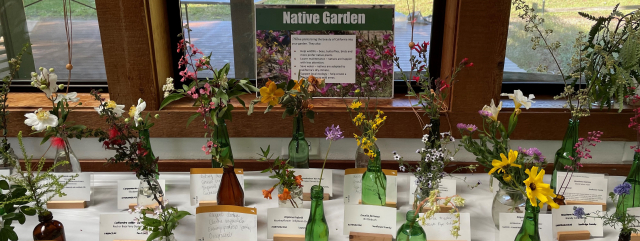(based on an article in the July-August 2016 Blazing Star Newsletter by Stephen Buckhout)
 Collectors are an essential part of every wildflower show; without them, and the plants they gather, there would be no show.
Collectors are an essential part of every wildflower show; without them, and the plants they gather, there would be no show.
A Day in the Life
 Collectors begin early in the day gathering all of the items they will need and loading them into their vehicles: bottles, buckets, clippers, loppers, extra water, newspaper or other material to wrap around collected specimens, a log for tracking the items collected, any required collecting permits, lunch, and clothing appropriate for whatever weather the day might bring.
Collectors begin early in the day gathering all of the items they will need and loading them into their vehicles: bottles, buckets, clippers, loppers, extra water, newspaper or other material to wrap around collected specimens, a log for tracking the items collected, any required collecting permits, lunch, and clothing appropriate for whatever weather the day might bring.
 Some days are hot, some are cold, and some are windy and wet, challenging even the hardiest collectors. Since flowers are best viewed in the day or two immediately after collection, there is little opportunity to wait for better weather. Collectors need sharp eyes, plant identification skills and a good memory to spot their target plants as they travel specific routes looking for flowers in bloom, collecting one or two samples of each to display at the show. They often work in groups of two or three.
Some days are hot, some are cold, and some are windy and wet, challenging even the hardiest collectors. Since flowers are best viewed in the day or two immediately after collection, there is little opportunity to wait for better weather. Collectors need sharp eyes, plant identification skills and a good memory to spot their target plants as they travel specific routes looking for flowers in bloom, collecting one or two samples of each to display at the show. They often work in groups of two or three.
Back at the Show
Once back at the show location, each specimen's identification is checked. Any specimens that cannot be identified in the field must be keyed to determine the correct identification, work often done by the same individuals who did the collecting.
 After identification is verified, the plant samples are placed in a display bottle and handed off to a runner, who will pull the corresponding species card and place the specimen in the appropriate location based on either the correct plant family or the relevant plant community. In the absence of runners, some collectors pull their own cards and place their specimens in the correct locations.
After identification is verified, the plant samples are placed in a display bottle and handed off to a runner, who will pull the corresponding species card and place the specimen in the appropriate location based on either the correct plant family or the relevant plant community. In the absence of runners, some collectors pull their own cards and place their specimens in the correct locations.
Collectors are among the last to leave the show location on the day prior to the event and may never be seen by those who attend the show. In a sense, they are like Santa Claus and his elves, toiling behind the scenes to deliver beautiful gifts to a public they may never meet.
Thanks to our Collectors!

 Collectors begin early in the day gathering all of the items they will need and loading them into their vehicles: bottles, buckets, clippers, loppers, extra water, newspaper or other material to wrap around collected specimens, a log for tracking the items collected, any required collecting permits, lunch, and clothing appropriate for whatever weather the day might bring.
Collectors begin early in the day gathering all of the items they will need and loading them into their vehicles: bottles, buckets, clippers, loppers, extra water, newspaper or other material to wrap around collected specimens, a log for tracking the items collected, any required collecting permits, lunch, and clothing appropriate for whatever weather the day might bring.



